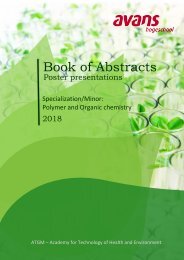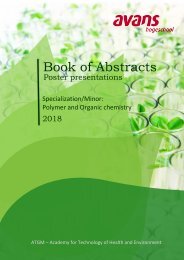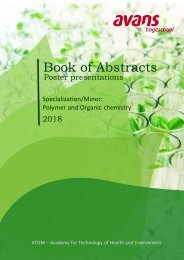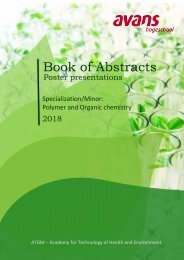Book of abstracts version 5
Create successful ePaper yourself
Turn your PDF publications into a flip-book with our unique Google optimized e-Paper software.
Synthesis <strong>of</strong> Beta-lactam in three steps<br />
<strong>Book</strong> <strong>of</strong> <strong>abstracts</strong> SPOC 2018<br />
Author<br />
Narjiss Ajary<br />
Academy <strong>of</strong> Technology for Health and Environment<br />
Avans Hogeschool, Breda<br />
Paula Contreras Carballada<br />
Erik Rump<br />
eta-lactam in three steps<br />
Abstract<br />
Beta-lactam molecules are a part <strong>of</strong> antibiotic families and are commonly used for the treatment o f bacterial infections.<br />
The important part <strong>of</strong> the molecule is the four membered ring, which gives the molecule its reactive characteristics to<br />
break down cell walls <strong>of</strong> the bacteria. To prevent the bacteria from becoming resistant to the commonly used Beta-lactam<br />
antibiotics, like Penicillin, different Beta-lactam derivatives are synthesised [1]. In this study, the synthesis is executed in<br />
three steps. The first step being condensation reaction with N-benzylhydroxylamine and Ethyl glyoxylate, which gives a<br />
Nitrone. The Nitrone is then used for the second synthesis, which is a 1,3 Dipolar Cycloaddition, with trimethylsilyl<br />
acetylene. The formed isoxazole is then used for the third synthesis, which is shown in Figure 1. A fluoride source is used<br />
to remove the trimethylsilyl group, which then gives the Beta-lactam product [2]. The goal <strong>of</strong> this study is to find an<br />
effective fluoride source for the removal <strong>of</strong> the trimethylsilyl group in the third synthesis. In the original research <strong>of</strong> …,<br />
TBAF is used, but this contains water which can protonate the intermediate and this doesn’t form the desired product [3]<br />
That’s why sodium fluoride was used. The obtained products were purified with column chromatography and analysed<br />
with H-NMR and FT-IR.<br />
Keywords: Beta-lactam, 1,3 Dipolar cycloaddition, isoxazole, nitrone, fluoride<br />
Table <strong>of</strong> content<br />
Figure 1: Reaction <strong>of</strong> the synthesis <strong>of</strong> the Beta-Lactam molecule.<br />
[1] C. Hubschwerlen (2007). B-lactam Antibiotics. Comprehensive Medicinal Chemistry II. 480-488.<br />
[2] P. DeShong et al. (1994) A New Approach to the Synthesis <strong>of</strong> Monocyclic B -Lactam Derivatives. J. Org. Chem. 6282-<br />
6286.<br />
[3] P. Contreras Carballada,(2003). Untersuchung zur Darstellung von 5 -trimethylsilyl-substituierten Isoxazolinen und<br />
deren Spaltung zu B-lactamen.<br />
57









